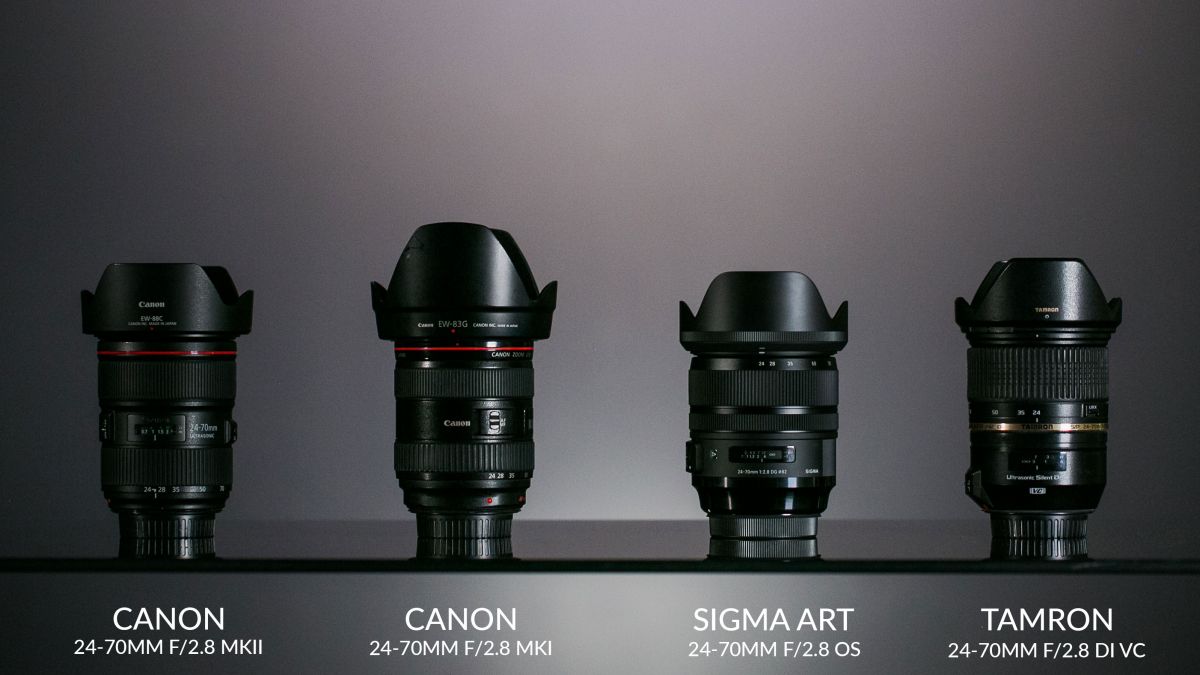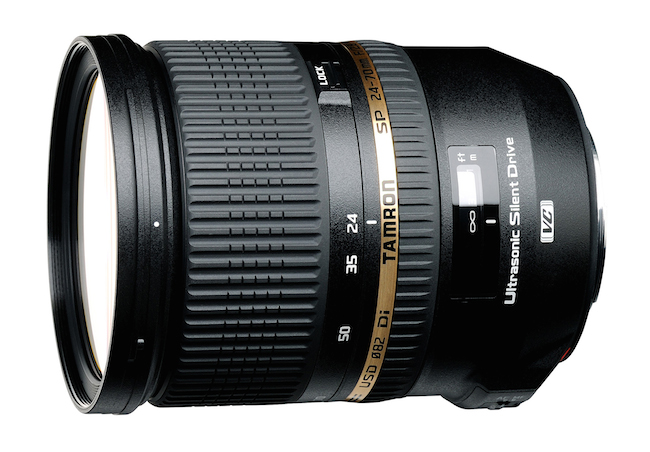
If you ask an experienced photographer what they would keep if they had to work with only one lens forever, many would answer “my 24-70.” It may not be as budget friendly or as fast of a first lens as other lenses like 35mm lenses or 50mm lenses, but once a photographer is sure they’re ready to dive in with a monetary commitment, a 24-70mm f/2.8 lens is a great starting place that covers a really useful focal length range. In this article, we’ll review why you need a 24-70mm lens and discuss the best options for each budget range.
Why Use a 24-70mm Lens?
Revisiting classic DigitalRev, this video sums up some great reasons to think about purchasing a 24-70mm lens if you haven’t got one already.
Some 24-70 lenses, like Canon’s 24-70mm f/2.8L II, for example, can rival primes in terms of sharpness. While time and energy can often be better spent on activities other than pixel-peeping, it’s definitely a satisfying feeling when you can zoom to 100% and find razor-sharp edges.
As mentioned several times throughout this article, a 24-70mm on a full-frame body is among the most versatile focal ranges you can find, which is its biggest selling point. Not only does it allow for a great deal of diversity in your portfolio with naught but a single lens, on a microcosmic level it allows for a diversity of looks on any individual shoot and is great for adaptation to circumstance.
For instance, on a pet shoot, where subjects can be notoriously all over the place, it’s really useful to be able to quickly change your perspective. Both ends can be good for close-up portraits of pets, with the wide end offering a quirky and fun look and the long end is more traditional. The wide end can also be great for including environmental elements for environmental portraits. The available range allows for more variety from the same subject and location than would a typical prime. Furthermore, it’s fast enough for low-light and subject isolation.

 Once you get used to fast apertures, it becomes painful to feel the constraint of slower glass. While f/2.8 obviously isn’t going to do as well in low light as f/1.2, it’s still plenty fast, and a fast 24-70 will have a fast 2.8 aperture throughout the entire focal range. This is ideal for low-light shooting, as you won’t lose any light at the long end, but the physics of constructing a lens with a constant maximum aperture do drive up the size and weight, and consequently, the price.
Once you get used to fast apertures, it becomes painful to feel the constraint of slower glass. While f/2.8 obviously isn’t going to do as well in low light as f/1.2, it’s still plenty fast, and a fast 24-70 will have a fast 2.8 aperture throughout the entire focal range. This is ideal for low-light shooting, as you won’t lose any light at the long end, but the physics of constructing a lens with a constant maximum aperture do drive up the size and weight, and consequently, the price.
The Drawbacks (Cons of 24-70mm lenses)
While the 24-70mm f/2.8 is a wonderful lens, and while it is incredibly versatile, it does have its limitations. While some versions are as sharp as a prime, they aren’t as fast at gathering light or at focusing. If you shoot in extremely low light or crave the blurriest of blurry backgrounds, you may want a fast prime in your camera bag.
Those fast primes can also be incredibly inexpensive by comparison, something that a good 24-70mm f/2.8 typically isn’t. If you scrimp and save to buy your kit and choose a 24-70mm f/2.8, it very well may be your only lens for some time due to the fact the best ones costs around $2k. Good thing it covers so many bases.
Another instance where primes have a leg-up is size and weight. 24-70mm f/2.8 lenses are usually packed with premium elements, and they are neither small nor light. If you’re shooting with one all day, a cramped wrist is not that unlikely.
You may find yourself wishing for a bit more reach when using a 24-70 on a full-frame camera. An answer to that dilemma is a 24-105mm f/4 lens. You gain some reach but lose some speed (though racked out at 105, even at f/4 you can arguably isolate a subject better), so it’s a definite trade-off.
Telephoto lovers, in general, may be underwhelmed, but a 24-70mm f/2.8 does dovetail beautifully with another good old photographer favorite – the 70-200mm. If you own them both, you’ve got a lot of important focal lengths covered.
On the other end, 24mm is wide but not ultra wide. If you crave a larger-than-life angle of view, you’ll have to look into something a bit more specialized.
The Best 24-70mm Lenses
The 24-70mm marketplace is ever-expanding and price points are falling. Most major brands have one and you can find multiple offerings from Canon, Nikon, and Sony. The third party manufacturers are, of course, waiting in the wings, should you decide you’d like a lower-budget but still a high-quality option. Tamron, Tokina, and Sigma all have versions.
It’s arguable whether a 24-70mm lens benefits much from image stabilization, but for those who know they’re shaky shooters, there are now a couple of options to help.
24-70mmm Lenses for Nikon DSLR Cameras
Nikon’s 24-70 release, the Nikon AF-S NIKKOR 24-70mm f/2.8E ED VR Lens, will set you back further than most, currently priced at $2,396.95 at B&H, but if you don’t want to spend as much and don’t mind third-party, Tamron has got you covered with their SP 24-70mm f/2.8 DI VC USD Lens, priced at a more modest $1,299.
The problem with the Tamron listed above, however, is two-fold. First, Tamron will be releasing a new 24-70 2.8 this year, and then of course there’s the Sigma which is not only brand new, but is in the much-loved ART-line, and costs only $1,299.
However, if you want to stick with a first-party lens there are options that are also more budget friendly. If you’re a Canon shooter and can handle a little bit slower of a lens, look into Canon’s EF 24-70mm f/4L IS USM Lens for a scant $899. This is a particularly good deal if you’re one of the aforementioned photographers who could use a little help staying steady, as this lens offers image stabilization at a much lower price point than the two mentioned above.
Sony’s got a similar offering in their Vario-Tessar T* FE 24-70mm f/4 ZA OSS Lens, still swimming in the shallow end of the price pool as far as these lenses go at $1,198 (but grab $100 off in instant savings if you’re ready to pick one up now!) As you can see, many of the options available depend on what camera brand you use, but it will be interesting to see what Sigma’s new 24-70mm f/2.8 DG OS HSM Art Lens brings to the table for multiple brands once we’ve got it in our hands.
As you can see, many of the options available depend on what camera brand you use, but it will be interesting to see what Sigma’s new 24-70mm f/2.8 DG OS HSM Art Lens brings to the table for multiple brands once we’ve got it in our hands.
Lenses Mentioned In This Article
- Sigma 24-70mm f/2.8 DG OS HSM Art
- Nikon AF-S NIKKOR 24-70mm f/2.8E ED VR
- Canon EF 24-70mm f/2.8L II USM
- Canon EF 24-70mm f/4L IS USM
- Sony Vario-Tessar T* FE 24-70mm f/4 ZA OSS
- AF-S NIKKOR 24-70mm f/2.8G ED – $1,796.95
- Canon EF 24-70mm f/2.8L II USM – $1,749
- Sony FE 24-70mm f/2.8 GM – $2198
- Sony Vario-Sonnar T* 24-70mm f/2.8 ZA SSM II – $2098
- Pentax HD Pentax-D FA 24-70mm f/2.8ED SDM WR – $1296
- Sigma 24-70mm f/2.8 DG OS HSM Art Lens for Canon EF $1299
- Tamron SP 24-70mm f/2.8 Di VC USD G2 Lens for Canon EF – $1199
- Tamron SP 24-70mm f/2.8 DI VC USD Lens for Canon Cameras – $1099
- Tokina AT-X 24-70mm f/2.8 PRO FX Lens for Canon EF – $949
IS A 24-70mm f/2.8 RIGHT FOR YOU?
Are you a photographer who, when asked what you like to shoot, pauses a moment to consider and replies, “Hmm, really I shoot a bit of everything?” If so, a 24-70mm f/2.8 is perfect for you. If you feel bogged down with a fixed focal length and want a walk-around, do-it-all type of lens, look into a 24-70mm f/2.8.
Do you, or do you want to, shoot weddings? A 24-70mm f/2.8 is a must-have in a wedding photographer’s kit, or any event photographer really. It keeps coming back to that versatility and aperture with this lens. – that’s really what a 24-70mm f/2.8 is all about. Wedding and event photographers need these things more than most as they navigate ever-changing circumstances and need to adapt, and fast, to capture moments everywhere.
You may notice that ‘f/2.8’ has been emphasized throughout this article, and that is fully intentional. There are 24-70mm f/4 lenses available and they are significantly less expensive than their f/2.8 counterparts, but with the stellar performance available in current 24-105mm f/4 lenses, and similar price tags to the f/4 versions of 24-70mm lenses, there’s not much reason to choose a 24-70mm f/4 over a 24-105mm f/4 if budget is a concern.
A final note – this post is based on the experience of shooting with a 24-70mm on a full-frame body. It’s still a great lens on an APS-C body, but you gain some reach and lose some of the wide end. If you’d like to try out a similar focal length on an APS-C body, look to a 17-55mm f/2.8 or a 17-50mm f/2.8. What are your thoughts on the 24-70mm lens?
CREDITS: All photographs are copyrighted their respective owners and have been used with permission for SLR Lounge. Do not copy, modify or re-post this article or images without express permission from SLR Lounge and the artists.











Get Connected!